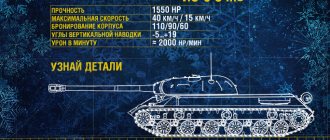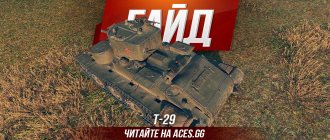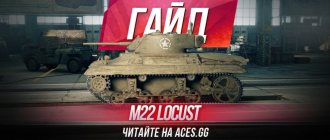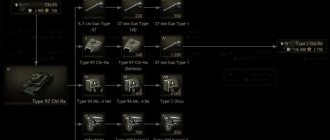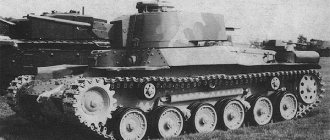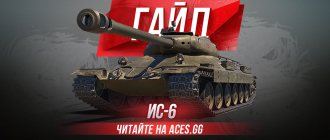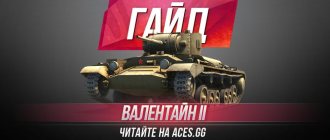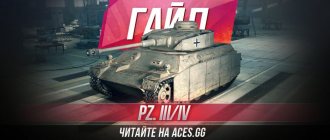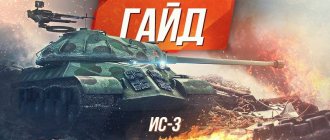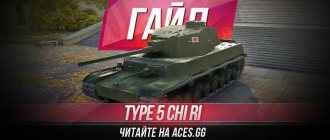Hello everyone and welcome to aces.gg! Friends, today our guest is the legendary and one of the most desirable vehicles in the World of Tanks expanse, one of the first premium tanks in our game - here is a guide to the Type 59.
It is noteworthy that this unit has a preferential level of battles, that is, it never fights against levels ten, and now the average Chinese premium tank of the eighth level Type 59 cannot be bought, since it was taken out of sale a very long time ago.
Type 59 armor
Regarding the armor characteristics of the Type 59, everything is still quite good. The main thing you need to know is the well-armored forehead of the turret, from which the shells of most enemies of the eighth level and below are deflected.
In terms of case hardness, everything is not so great, but not bad either. The NLD and VLD are 100 millimeters thick, located at very favorable angles and can withstand blows well, although it is still better to hide the body. The Type 59 WoT tank is capable of tanking even sideways, but only if positioned correctly and not always.
Regarding mobility, everything is relative. On the one hand, it has good maximum speed and maneuverability, but by the standards of medium tanks, the dynamics are average, although the car cannot be called tight, the Chinese Type 59 tank is quite playful.
Type 59 gun
Now let's talk about weapons and here again there are some contradictions. For starters, alphastrike, which is quite a bit higher than most level eight premiums, but there is nothing surprising here.
As for the rate of fire, it is not very high and therefore the Type 59 gun is capable of inflicting only 1700 base damage per minute, without taking into account the equipment and skills of the crew. The same applies to armor penetration, it is small and not enough to farm well. For this reason, you will have to carry half of the gold ammunition with you. By the way, pay attention, the ammunition here is small, so shoot wisely.
The accuracy of the Type 59 in World of Tanks is generally a problem. Large scatter, very long mixing, as for CT, and disgusting stabilization, these parameters will need to be corrected in every possible way. The only good thing is that the gun is inclined 7 degrees downwards, especially if we remember that we have a Chinese one in our hands.
Fighting machine of the Celestial Empire
The successful design of the T-55 has led to the fact that tanks created on its basis and modernized using new technologies still represent a very impressive force, especially if they do not have to meet with the latest generation of enemy equipment
After the end of World War II, fighting in China did not end. Until 1950, a civil war raged here between the communist People's Liberation Army of China (hereinafter referred to as the PLA) and the armed forces of the Kuomintang. The Soviet Union supported its ideological allies in various ways - including by supplying them with armored vehicles. In particular, the USSR transferred captured Japanese tanks to the communists in exchange for food supplies from Manchuria to the Soviet Far East.
After the end of the war, China began to receive Soviet-made armored vehicles - heavy tanks IS-2, medium T-34-85, self-propelled guns SU-100, etc. In 1956, the USSR supplied its new Far Eastern ally with several copies of the latest T-54A tank and technical equipment documentation for its production.
How the T-54 tank became “Chinese”
The T-54 was a very successful innovative machine. In total, it was in service with tank units of the USSR for more than thirty years, and at the time of the transfer of rights to its production to China, it was the main tank.
Decontamination of Type 59 tanks during exercises Source - china-defense-mushup.com
The leadership of the People's Republic of China launched its own tank production in the urban district of Baotou in the province of Inner Mongolia, assigning the newly built enterprise No. 617. Today, this enterprise is the state-owned “First Machine-Building Corporation of Inner Mongolia” - the only manufacturer of battle tanks in the PRC. The corporation is part of the state-owned industrial group CNGC Norinco Group (China North Industries Corporation), a key Chinese manufacturing association engaged in both the production of military equipment and engineering products aimed at meeting civilian needs.
The construction of the plant in Baotou and the launch of the tank into production were carried out with the participation of Soviet specialists simultaneously with 156 other key industrial facilities built in the PRC during the first five-year plan. Initially, it was planned to produce up to a thousand licensed T-54A tanks per year. In addition, a specialized research institute-201 was created in Beijing, which was engaged in the design development of armored vehicles.
Chinese workers assembled the first tank in 1958 from Soviet components. The vehicle was assigned the production index WZ-120, and when put into service, the tank received the index “Type 59” (Type 59). The first 32 Type 59 vehicles took part in the Beijing parade on October 1, 1959, dedicated to the 10th anniversary of the founding of the People's Republic of China. In subsequent years, these tanks became permanent and mandatory participants in such events. The starting series vehicles completely repeated the design of the Soviet T-54A tank, and in subsequent modifications, Chinese engineers began to make some changes that better adapted the vehicle to the climatic conditions of Southeast Asia.
Removing the turret from a Type 59 tank using a Type 84 BREM crane Source - armyrecognition.com
In 1960, due to insults exchanged between the heads of China and the USSR, Mao Zedong and N.S. Khrushchev, there was a rupture in relations between the two countries. First of all, it affected military-industrial cooperation, so the Baotou plant soon faced a shortage of components, many of which at that time were supplied from the USSR. As a result, the production plan of 1,000 tanks per month was not fulfilled, and the Chinese urgently had to resolve the issue of establishing production of units previously supplied from outside.
By 1967, the plant reached a capacity of 600 cars per year and subsequently only increased its productivity. In turn, NII-201 intensified work to improve the Type 59 design. Over the next years, the Chinese followed the path of gradual improvement of the technology they had already mastered and its deep modernization, up to the creation of new types of equipment. However, soon the “Cultural Revolution” began in China, the most destructive period of which, resulting in mass arrests of the intelligentsia, including technical ones, occurred in 1966–69. This had a negative impact on both the development of Chinese industry in general and tank building in particular.
Design of the Type 59 tank
Like the T-54, the Type 59 has a classic layout - the control compartment is located in front, followed by the fighting compartment, and the engine and transmission compartment is located in the stern. The tank hull is welded from rolled homogeneous steel armor plates. The thickness of the frontal armor is 97 mm, the slope of the upper part is 60°, the lower part is 55°. The thickness of the sides is 79 mm, the stern is 40–45 mm, the bottom is 20 mm, the hull roof is 30 mm. The thickness of the front wall of the cast tower reaches a thickness of 203 mm, the side walls – 80 mm, and the rear wall – 65 mm. Thanks to the hemispherical shape, the walls of the tower are located at rational, varying angles of inclination. The weight of the tank is 36.5 tons. Crew - 4 people: commander, driver, gunner, loader.
“Type 59” during exercises during the day Source – china-defense-mushup.com
A Chinese copy of the Soviet B-54 diesel engine with a power of 520 hp was installed in the engine-transmission compartment of the tank under the designation 12150L. With. at 2000 rpm. The Type 59 transmission, identical to the T-54A, used a new element, the “guitar,” to transmit power from the engine to a parallel gearbox (hereinafter referred to as the gearbox). It is a gearbox with a gear ratio of 0.7. Thanks to this, the gearbox was designed to be compact and simple (five-speed manual). The chassis of the Type 59 tank used the principle of an individual torsion bar suspension. The support rollers were installed with a large diameter, five per side. The tracks were made 580 mm wide, fine-linked with an open metal hinge and lantern engagement with the drive wheel. Each of them consisted of 90 tracks.
The fuel supply of 532 liters is located in three external and three internal tanks, in addition, at the rear of the hull there is a mount for a two-hundred-liter external tank.
Initially, the Type 59 was equipped with a 100-mm rifled gun "69", which was a licensed version of the Soviet D-10TG gun installed on the T-54A. Almost right next to the muzzle of the gun there is an ejector necessary for purging the barrel bore of powder gases. Initially, the gun was equipped with a single-plane stabilizer, which stabilized the gun in a vertical position and increased the tank's firing accuracy on the move. However, due to the breakdown of relations with the USSR, the installation of stabilizers on guns ceased, and the installation of night vision devices also ceased (tanks left the assembly shop without them).
The pointing angles of the D-10TG gun were −5°...+18°, which in combat conditions in mountainous or hilly terrain could create certain inconveniences, especially when firing from a hill. The effective firing range varied between 700–1200 m. To fire the cannon, a Chinese-made telescopic articulated sight with variable 3.5- and 7-fold magnification was used, which was a copy of the Soviet TSh-2A-22.
“Type 59” during exercises at night Source – china-defense-mushup.com
The tank's ammunition consisted of 34 unitary rounds, 20 of which were in the rack to the right of the driver's seat, and another 14 in the fighting compartment. To the right of the gun was mounted a coaxial 7.62-mm Type 59T machine gun, a licensed version of the Soviet SGMT. A second similar front-mounted machine gun was rigidly mounted in the front plate of the tank. The ammunition load of both machine guns was 3,500 rounds. A large-caliber 12.7-mm Type 54 machine gun, which was a licensed copy of the Soviet DShKM, was mounted on the roof of the turret above the loader's hatch. Its ammunition capacity was 200 rounds.
Type 59-I
In the early 1960s, the Type 59 tank was modernized in China. The characteristics of the new modification “Type 59-I” (production index - WZ120A) brought this tank closer to the Soviet T-54B. The vehicle was equipped with a two-plane weapons stabilizer (analogous to the Soviet Cyclone), as well as active night vision devices. The ammunition load of the 69-II cannon (analogous to the Soviet D-10T2S) has increased to 44 unitary shells. For the tank, the Chinese began to produce a new armor-piercing sub-caliber projectile (hereinafter referred to as BPS) AR100-2 with an elongated core, developed by one of the companies belonging to the NORINCO group. The tank gun received a new ejector design, independently developed in China.
The British company MEL supplied China with tank night vision devices, which began to be installed on Type 59-I tanks. Now the commander and gunner were provided with infrared sights, and the driver was provided with a night observation device. These tanks could be easily distinguished by their Type 82 or Type 83-II laser rangefinders from the Chinese company CELEC, mounted above the gun mantlet - in a place extremely vulnerable to small arms fire and shrapnel. They began to be installed on tanks in the late 1970s, so during the Sino-Vietnamese War of 1979, some of the equipment participating in the fighting was already equipped with them. The Type 82 made it possible to measure the distance to a target at ranges of 300–3000 meters with an accuracy of 10 m. In addition, the vehicles began to be equipped with analog ballistic computers. Data was entered into them manually using a push-button control panel.
Medium tank "Type 59-I" Source - armor.kiev.ua
All Type 59 tanks in service with the PLA were upgraded to Type 59-I.
Modernized Type 59AP vehicles were produced especially for Pakistan, distinguished by the presence of a lattice basket welded to the rear of the turret and smoke grenade launchers on its sides. These tanks were also produced in significant quantities in Pakistan by the local company Heavy Defense Industries in cooperation with NORINCO, and in the early 2000s, Pakistan developed a modernized version called Al-Zarrar. They are still in service with the Pakistani armed forces and take part in combat operations against Islamic extremists.
Type 59-II
In the early 1980s, the gun of the Type 59-I tank was replaced by an Israeli-made 105-mm rifled gun "81", which was a copy of the American M68 tank gun (the Israelis armed their Shot and Merkava tanks with these guns Mk.1 and Mk.2). The Americans, in turn, when creating the M68, copied the design of the British-made 105-mm Royal Ordnance L7, purchasing the appropriate license. They installed their guns on M48A5, M60 and M1 Abrams tanks of the early series. These guns performed well in the Six Day War and the Yom Kippur War, where the main opponents of the Israelis were the T-54/55 and T-62, the design of which is also in many ways similar to the Type 59. In China, the tanks and guns that fired at them in the Middle East were combined into one vehicle, designated Type 59-II (WZ-120B).
At that time, the Israelis already had experience in rearming captured Egyptian and Syrian T-54s with 105 mm guns. Such tanks entered service with the Israel Defense Forces under the designation “Tiran-4Sh” - “Sh” (in Hebrew, the letter “shin”) means “sharir” (strong). So the Chinese did not have any particular problems with upgrading their vehicles, especially since the dimensions of the new guns were almost identical to the 100 mm 69-II. The weapon stabilizer remained the same as that used on the Type 59-I. For the new gun, NORINCO created a 105-mm feathered BPS with a uranium alloy core of increased penetration power. The 100-mm gun's BPS had an initial speed of 1,480 m/s and an armor penetration of 150 mm at a range of 2,400 meters at an angle of 65°, and a 105-mm OBPS with a uranium alloy core was capable of penetrating 150 mm thick armor at a range of 2,500 m at an angle of 60° . The tank's ammunition also included high-explosive and cumulative shells, the production of which was established in China using Israeli technology. The Type 59-II's ammunition load remained the same as that of the "59-I" - 44 rounds.
Type 59-II tanks in service Source - vooruzenie.ru
Externally, the Type 59-II differs from the Type 59-I by the ejector, which was moved much closer to the turret and increased in size. The Type 59-II also featured non-illuminated night vision devices, rubberized side screens and smoke grenade launchers. The laser rangefinder was moved from the platform above the gun to the commander's cupola. Tanks equipped with such equipment received the “Type 59-IIA” index.
Type 59-IID
In the 1990s, China began to modernize its Type 59-II - the new machine received the index “Type 59-IID” (WZ-120C). The latest fire control system (hereinafter referred to as the FCS) was installed, including new combined (day/night) passive sights for the commander and gunner, an auxiliary telescopic sight, a built-in laser rangefinder, an improved two-plane weapon stabilizer and a digital ballistic computer. Instead of a periscope sight, the gunner could be provided with a thermal imager.
The 105 mm gun was modernized and received a new designation “Type 83-I” (83A).
The tank was equipped with FY dynamic protection elements, which are box-shaped containers with explosives. 13 containers protect the frontal part of the hull, and another 30 are placed on the cheekbones of the turret (15 on each side). Also, four smoke grenade launchers were installed on the sides of the turret, and in the rear part there was a basket for the crew’s property, which at the same time serves as an additional anti-cumulative screen. On top of that, the tank was equipped with thermal smoke equipment that uses fuel as a reagent.
Medium tank "Type 59-IID" Source - armor.kiev.ua
The engine of the car was boosted by increasing the fuel supply and compression ratio, which made it possible to increase the power of the 12-cylinder diesel engine 12150L7 to 580 hp. With. The speed of the tank when driving on the highway reached 50 km/h, off-road - 25, and the cruising range increased from 360 to 440 kilometers (with additional tanks reaching 600). The steel track joints were replaced with rubber-metal ones, and the torsion bar shafts were strengthened. A new A-220A radio station was installed on the tank, allowing communication at distances of up to 16 kilometers.
Type 59 for sale
For foreign buyers, a special modification of the tank was developed - “Type 59-IID1” (WZ120C1). The 105-mm "79" gun was equipped with an aluminum-composite heat-insulating casing. A guided weapon system was installed on the tank, allowing it to fire anti-tank guided missiles (ATGMs) through the barrel with a maximum firing range of up to 5.2 kilometers and armor penetration of up to 700 millimeters. It is also possible that the possibility of installing the Soviet-developed 9K116-1 “Bastion” complex, designed to fire from 100-mm rifled guns of T-54 and T-55 tanks, was envisaged. In addition to ground targets, such systems can also destroy low-flying air targets (for example, helicopters).
In the 1980s, export versions of the Type 59 tank were produced in small batches:
- “Type 59R” - with a new control system, anti-nuclear protection system, steel bulwarks, “Type 79” gun;
- “Type 59P” – with reinforced armor for the turret and frontal part of the hull, “Type 79” gun;
- “Type 59G” (“Type 59–125/59–120”) – with a new turret, a new fire control system, 580/1200 hp engine, 120/125 mm smoothbore gun Rh-120-L44 (unlicensed copy of the Soviet 2A46 ).
Production of Type 59 tanks was carried out in China until 1987. It was produced in parallel with the less popular Type 69 tank, and then they were replaced by the Type 79 and other second-generation tanks. There are at least two known attempts by the Celestial Empire to increase the number of production sites where tanks would be assembled. The so-called “branch No. 704”, built at the Luoyang Tractor Plant in 1970, was able to produce only 100 tanks in ten years. Most likely, Luoyang encountered problems related to product quality (technological level of production, labor qualifications, etc.). In the early 1970s, there was a project to build a second full-fledged tank, but it was not implemented.
The total production volumes of the Type 59 tank are not precisely known. In the 1970s, China produced 500–700 cars per year, in 1979 – 1000, in 1980 – 500, in 1981 – 600, in 1982 –1200, in 1983 – 1500–1700 units. After 1980, almost all production was exported. The estimated number of manufactured tanks of this model of all modifications is 10 thousand units.
“Type 59–120” with a 120 mm cannon Source - armor.kiev.ua
A significant number of Type 59 tanks were exported to the following countries: Albania (470), Bangladesh (about 100), Iran (500), Iraq (about 700, mostly modernized versions), Congo (15), Cambodia (about 50) , North Korea (175), Pakistan (1200 - including those produced under license), Vietnam (350), Zimbabwe (35), Tanzania (30), Sudan (50). Most of these countries still operate Chinese tanks or are considering the possibility of repairing and modernizing them.
According to Western sources, as of 2012, there were 4.3 thousand Type 59 tanks in service and storage in China.
Based on the Type 59, other vehicle models were created, which, according to the Chinese classification, belong to the first generation of tanks:
- “Type 62” (WZ-131) was a tank lighter by 15.5 tons due to thinner armor, a lighter chassis and a smaller caliber gun (85 mm). Produced until 1989;
- “Type 69” (WZ-121) - was distinguished mainly by a 100-mm smoothbore gun, developed in China based on data obtained from the study of the Soviet T-62 captured on Damansky Island. Produced until 1987 in small batches, mainly for export.
"Type 59" in battles
The Type 59 tanks received their baptism of fire in the Third Indo-Pakistani War of 1971. During the Second War of 1965, the Pakistani military leadership lost confidence in American tanks, since at Assal-Uttar alone, in a battle with the Indian Centurions, the Pakistani armed forces lost about a hundred M48 Patton vehicles, which is why the battle site was called “Patton Nager.” - Patton Cemetery. In the second half of the 1960s, Pakistan began to closely cooperate with China, and by 1971 its army was armed with 700 Type 59 tanks.
On the night of March 25, 1971, Operation Searchlight was launched by the Pakistani army against the Bangladeshi rebels from the Mukti Bahini movement, who advocated the secession of East Pakistan and the creation of an independent state of Bangladesh. As a result, a civil war broke out, in which the Indian army entered on the side of Bangladesh in December 1971. The problem arose of distinguishing the Indian T-54/55 purchased from the USSR from the Pakistani Type 59. The Indians installed false additional ejectors of increased size on their tanks at a distance of 2/3 of the barrel length from the turret. Thanks to this, the D-10 cannon from a distance began to resemble the English L7, which was armed with the Indian Centurions and Vijayats. Thus, the Indian T-54/T-55 were different from the Pakistani Type 59 even from a great distance. The Pakistanis marked their Type 59s with horizontal white stripes about 25 cm wide around the turret with a break on the left and right sides for the number, as well as a white stripe on the gun ejector.
Tank "Type 59-AR" of the Pakistani army Source - otvaga.narod.ru
China began supplying tanks to the North Vietnamese government quite late, at the end of 1971. On March 30, 1972, Hanoi carried out a massive offensive operation against the troops of South Vietnam, nicknamed by Western media the “Easter Offensive,” in which for the first time the infantry of the Vietnamese People's Army was supported by tank units - the 201st, 202nd and 203rd regiments, which were armed with and Chinese Type 59. Subsequently, these and other tank units took part in battles in South Vietnam until the complete victory of the DRV troops over the enemy.
The next time Vietnam encountered Type 59 tanks was during the 1979 Sino-Vietnamese War. Due to the expulsion of the Chinese diaspora from the territory of North Vietnam and the political confrontation that arose in Laos, on February 17, 1979, PLA units invaded Vietnamese territory. China's offensive used Type 59 tanks, lightweight Type 62 tanks, and Type 63 amphibious tanks. In Vietnam, most of the tank units were concentrated in Laos and on the border with it, so mainly outdated T-34-85 took part in the fighting. After a month of fighting, PLA units returned to Chinese territory. In total, the PLA lost up to 260 armored vehicles in combat, including armored personnel carriers and infantry fighting vehicles.
Soldiers of the South Vietnamese army on the armor of a captured Type 59 tank, captured during the Easter Offensive by their opponents. Source - adamalla.com
Chinese tanks were readily purchased by Iran, which lost the opportunity to purchase armored vehicles in Europe and the United States after the 1979 revolution and the expulsion of the Shah from the country. In the early 1980s, 750 Type 59 tanks were purchased from China, which took part in battles with the Iraqi army in the Iran-Iraq War of 1980–88. Due to repressions carried out against members of the Communist Party, Iraq for some time in the 1980s lost the ability to purchase equipment from the USSR. Therefore, in 1980, Saddam Hussein concluded a deal to supply the Iraqi army with seven hundred Type 59 tanks and thousands of Type 69 tanks, of which China supplied about 600 vehicles before the end of the war.
Iraq's remaining Type 59 and Type 69 tanks were completely destroyed by the US Army and allied countries as a result of Operations Desert Storm and Desert Saber in 1991, as well as the invasion of Iraq by coalition forces in 2003 year. These outdated tanks were unable to provide any noticeable resistance to the enemy.
Abandoned Iraqi Type 59 tank Source - en.academic.ru
Almost nothing is known about the participation of tanks in the civil war in Sudan, since both sides do not welcome the dissemination of information about the progress of the fighting. In general, it can be stated that the successful design of the T-54 has led to the fact that tanks created on its basis and modernized using new technologies still represent a very impressive force, especially if they do not have to meet with the latest generation of enemy equipment. In this regard, the countries of the Third World still actively use this technology, constantly modernizing it.
Equipment for Type 59
We looked at the general characteristics of this vehicle, highlighted its advantages and disadvantages, and as you can see, our main problems are poor gun accuracy and low DPM. For these reasons, the following equipment is installed on the Type 59: 1. – everything is very clear, this is the best way to increase damage per minute. 2. – will improve the accuracy and stabilization of the gun; 3. is an excellent option, because it boosts a large number of important characteristics at once.
There are several alternatives to the third item on our list. If you are a fan of playing from the review and consider this characteristic to be very important, you can install it, and for those who really lack mixing speed (it’s really bad), you can take it. Both options have the right to life, here everyone must set priorities for themselves.
Modules
|
|
|
|
|
Type 59 crew training
Based on the fact that we have a crew and four people at our disposal, at a certain stage we will have to make a decisive choice. However, otherwise we will download perks for the Type 59 according to the standard, strengthening the most important parameters of the vehicle and not forgetting to correct the shortcomings: • Commander – , , , . • Gunner – , , , . • Driver mechanic - , , , . • Loader (radio operator) – , , , .
In the case of the radio operator, it makes sense to replace it with, since this module is located along the entire starboard side and there is a high probability of its damage, again, it’s up to you to decide.
How to get
During the “New Year's Offensive 2018” promotion, you could buy boxes. In one of which the Type 59 was hidden.
Tactics for playing the Type 59
Considering everything said above, you need to play with this vehicle carefully, because although it has good armor, there are enough vulnerable areas. At the same time, keeping in mind our scythe gun, on the Type 59, combat tactics consist of positioning on the second line.
In situations where you don’t get caught in light, you can safely deal damage by targeting weak spots. If the enemy points the muzzle at your Type 59 tank, try to take a position where artillery cannot reach you and the hull will be hidden, tanking with a turret at medium distances is a pleasure to shoot back.
But when close combat cannot be avoided, try to move more, wiggle your body from side to side, facing the enemy with your forehead, so the likelihood of getting a ricochet or non-penetration greatly increases. Otherwise, the Type 59 World of Tanks tank is an excellent support vehicle. Change flanks and attack directions, help your allies, hide behind heavy ropes and always look at the mini-map.
To summarize, let me remind you that the Chinese Type 59 medium tank cannot be purchased; it was taken out of sale a long time ago. But if you get the chance to get your hands on one, decide what you expect from this car. If you want to farm, there are better options, but if you need a good and fairly rare unit, this is a good option.
